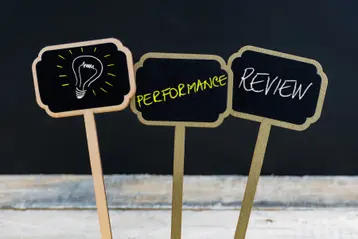Top Five Tips for Conducting an Effective Performance Review Virtually

Table of contents
- 1.Setting
- 2.Measure Performance
- 3.Don’t Forget About Career Growth
- 4.4. Provide Opportunities to Hear Feedback
- 5.Leverage Technology
As we kick off the new year, many companies will begin their annual review processes. Reviews will most likely look different this year. Many companies shifted from in office workplaces to remote workforces during the pandemic and may be torn with how to maneuver performance reviews this year.
It is important to review performance for all employees, even if they are remote and even during a pandemic. It may be easy for remote employees to feel neglected or distant from an organization because they do not regularly interact with coworkers face to face. Performance reviews give managers the opportunity to reset expectations and praise performance, reconnecting the employee to the company’s goals. When conducting performance reviews remotely, it is important to remember these five factors when planning and conducting the review meeting.
1. Setting
With in-person reviews, a manager can take steps such as reserving a conference room to ensure that the review meeting is confidential. This is not necessarily the case when conducting reviews remotely. It is important to remind the employee that they should be in a private space away from as many distractions as possible during the meeting. Managers should take their employee’s personal circumstances into consideration when scheduling the meeting and ask for feedback on the best time of day to conduct the performance review. For example, nap time might be an ideal meeting time for employees who are managing working while caring for young children during the pandemic.
2. Measure Performance
It is always important to review employees’ performance based on measurable metrics, but it is especially true for remote employees. Without performance measurements, it is difficult to see how they are contributing to the workforce. We recommend using the tried and tested SMART goal methodology to create goals that are specific, measurable, attainable, relevant, and time bound. This way employees know exactly what they should be doing and what their performance is measured on.
If an employee’s role shifted during the pandemic, it is important to account for this in the performance review. Managers should recognize and be lenient regarding goals that were unattainable as workplace priorities may have shifted in light of COVID-19.
Additionally, many managers get bogged down checking to see if remote employees are visibly “online” and logged into the company’s computer systems. Many jobs do not require an employee to be online and available between 8 am to 5pm and allow for flexibility, but managers are fearful that their employees are not actually working. Managers then begin to monitor an employee’s status instead of focusing on the work an employee is actually completing. Unless the job specifically requires an employee to be online during a specific time, employees should not be evaluated regarding their system status as a performance metric. Measure their contributions, responsiveness, productivity and creativity, not how frequently their green light was showing available on the internal team chat tool.
3. Don’t Forget About Career Growth
Managers sometimes forget that remote employees want career development opportunities just as much as employees who work in the office. This is especially true during the pandemic as many employees found their responsibilities and priorities shifted, potentially resulting in newfound job interests. Managers should use the performance review time to discuss career growth, development, and advancement opportunities with all employees.
4. Provide Opportunities to Hear Feedback
Managers should ensure employees have the opportunity to provide feedback during the performance review meeting. Prior to the meeting, managers should not only plan out what they will say during the review meeting, but also plan for the areas where they want to solicit employee feedback. Let the employee know prior to the performance review meeting to come prepared to share feedback on how the manager could better support the employee over the course of the next year, or what they need to be successful in their current role. Setting the stage for two-way dialogue will ensure that the manager is not the only one speaking! It also ensures the employee is engaged in the conversation and in their own career growth. It is important to avoid a situation where the manager dominates the review meeting.
5. Leverage Technology
Even though the review meeting will take place virtually, it is best to use video conference tools when available. Video conferencing helps the manager and employee watch physical cues from one another. Managers should have the performance appraisal document accessible and be ready to share their screen as they go through the document. This allows the employee to follow along.
Companies who regularly conduct remote reviews should consider adopting a web-based performance management system. These systems typically have features such as a self-assessment step, real time performance data, and review tracking that streamlines the review process, particularly for remote employees.
This communication is for informational purposes only; it is not legal, tax or accounting advice; and is not an offer to sell, buy or procure insurance.
This post may contain hyperlinks to websites operated by parties other than TriNet. Such hyperlinks are provided for reference only. TriNet does not control such web sites and is not responsible for their content. Inclusion of such hyperlinks on TriNet.com does not necessarily imply any endorsement of the material on such websites or association with their operators.

Kelly Pacatte
Table of contents
- 1.Setting
- 2.Measure Performance
- 3.Don’t Forget About Career Growth
- 4.4. Provide Opportunities to Hear Feedback
- 5.Leverage Technology

